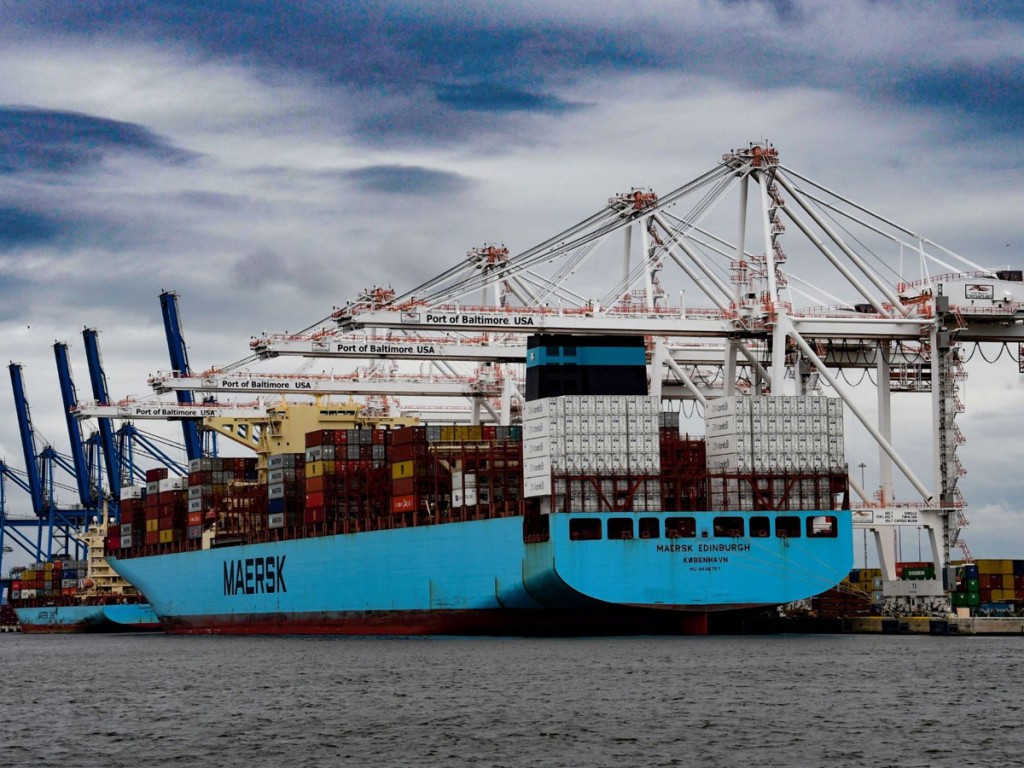Port of Baltimore sets new record for most container moves from one ship
Aug 19, 20205,536 moves from Maersk Edinburgh seen as sign of economic vitality
A new record was set last night at the Helen Delich Bentley Port of Baltimore’s Seagirt Marine Terminal, with 5,536 container moves conducted by longshore workers handling the Maersk Edinburgh over three days with the final move completed at 11 p.m. It was the largest number of moves for a single ship in the Port’s 314-year history, surging past the previous record of 5,181 moves set last year. Container moves are the number of times an imported container is unloaded from a ship, as well as when an export or empty container is loaded onto a ship.
“This record container activity is a significant milestone for the Port of Baltimore and a sign that the maritime shipping industry is coming back and fueling Maryland’s economic recovery,” said Governor Larry Hogan. “The container growth at the Port of Baltimore shows the benefits of public-private partnerships in delivering infrastructure more quickly and stretching state and federal dollars by also relieving the state of the long-term infrastructure maintenance costs.”

The Maersk Edinburgh has a capacity of 13,092 Twenty-foot Equivalent Unit containers. The supersized vessel arrived at the Port of Baltimore on August 16 and departed late last night. Maersk Line is a member of the 2M shipping alliance with Mediterranean Shipping Co., which also includes a strategic cooperation slot sharing arrangement with another global shipping line, ZIM Line.
“We’re seeing more containerized cargo coming into the Port of Baltimore because we maximize cooperation with the private sector,” said William P. Doyle, executive director of the Maryland Department of Transportation Maryland Port Administration (MDOT MPA). “The Port of Baltimore thrives on its growing, open-for-business focus to attract partnerships, including e-commerce-related warehousing, distribution and fulfillment centers.”
Massive ships such as the Maersk Edinburgh can call on the Port of Baltimore because of infrastructure that can accommodate some of the largest vessels in the world. The 50-foot berth that allows access for these ships was built as part of the public-private partnership (P3) between MDOT MPA and Ports America Chesapeake, which operates Seagirt Marine Terminal. In addition to the deeper berth, the 50-year agreement, forged in 2009 in the wake of a national recession, generated thousands of jobs, installed four supersized container cranes at the Port and also included $100 million for Maryland roads, bridges and tunnels. -more-
The P3 agreement with Ports America Chesapeake continues to solidify the Port’s position as Maryland’s economic engine. Work is progressing on a second 50-foot berth that will allow the Port to accommodate two massive ships at the same time. That berth, and four additional supersized cranes, are expected to be operational by summer 2021. The $116.4 million investment includes $103 million from Ports America, $7.8 million from the state and $6.6 million in federal funding.
The agreement has resulted in increased tax revenue for the state due to increased cargo operations, and has generated funds for the Transportation Trust Fund. The growing container business at the Port has also spurred the planned expansion project for the Howard Street Tunnel in Baltimore. That project will allow double-stacked rail cars to move cargo quicker and with more efficiency from the Port, and is also benefitting from a public-private investment from the state, CSX and others.
“The experience at the Port shows us that during challenging economic times, innovative thinking and strong partnerships can help you make progress you wouldn’t otherwise be able to achieve,” said Transportation Secretary Greg Slater.
“This public-private partnership not only improved the Port’s infrastructure and capacity during a time of economic recovery, but it continues to pay dividends in job growth, increased tax revenue and overall economic impact.”
Similar Stories

Simons new COO of Port of Rotterdam Authority
View Article
Wilson Sons certifies an unprecedented reduction of up to 55% in greenhouse gas emissions from Santa Clara Container Terminal cargo operations
View Article
Charleston maritime partners calling on community to help fill shipping container with toys for SC foster children
View Article
Total volume surges with second-busiest September ever at Port of NY and NJ
View Article
Gateway Terminal in Connecticut to receive $34M federal investment in electric and zero-emissions equipment
View Article
Waterfront work stoppages simultaneously hit British Columbia ports and Montreal
View ArticleGet the most up-to-date trending news!
SubscribeIndustry updates and weekly newsletter direct to your inbox!





